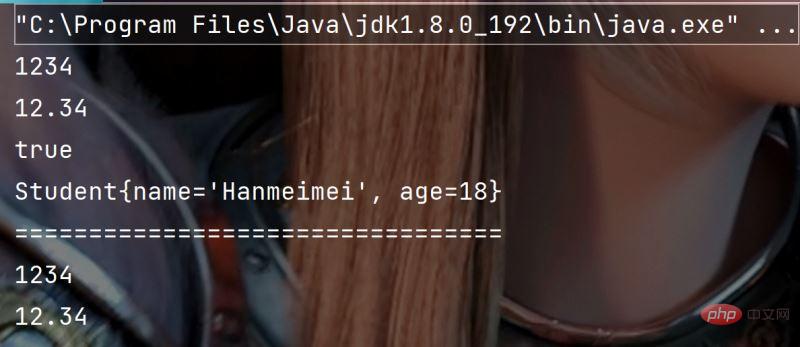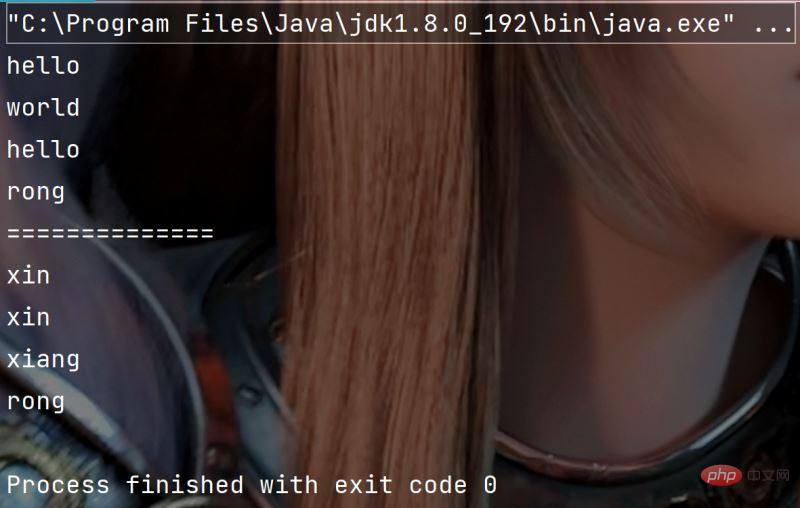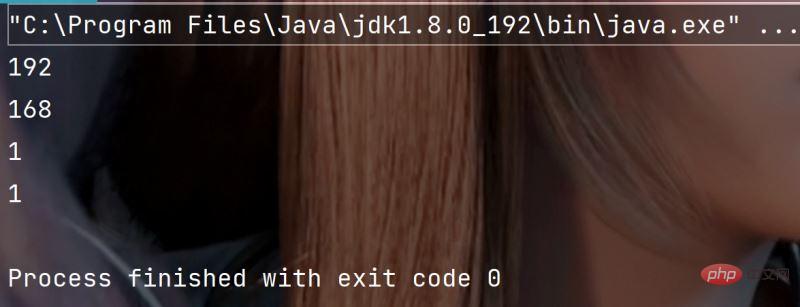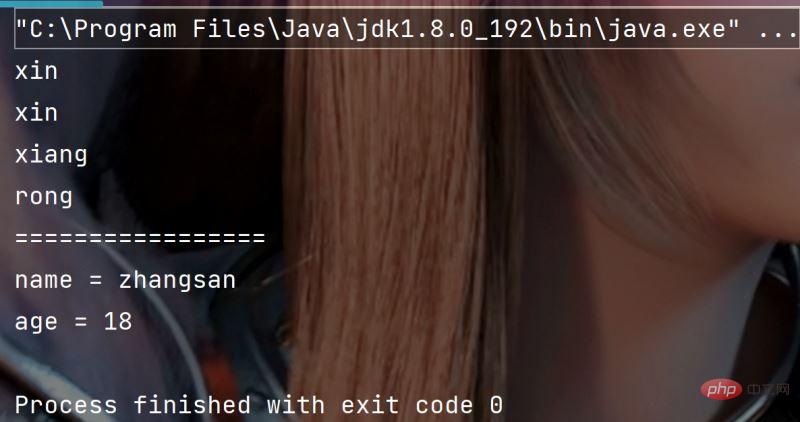Java中String類常用方法(總結分享)

推薦學習:《》
一. String物件的比較
1. ==比較是否參照同一個物件
注意:
對於內建型別,==比較的是變數中的值;對於參照型別 , == 比較的是參照中的地址。
public static void main(String[] args) {
int a = 10;
int b = 20;
int c = 10;
// 對於基本型別變數,==比較兩個變數中儲存的值是否相同
System.out.println(a == b); // false
System.out.println(a == c); // true
// 對於參照型別變數,==比較兩個參照變數參照的是否為同一個物件
String s1 = new String("hello");
String s2 = new String("hello");
String s3 = new String("world");
String s4 = s1;
System.out.println(s1 == s2); // false
System.out.println(s2 == s3); // false
System.out.println(s1 == s4); // true
}2. boolean equals(Object anObject)
按照字典序進行比較(字典序:字元大小的順序)
String類重寫了父類別Object中equals方法,Object中equals預設按照==比較,String重寫equals方法後,按照 如下規則進行比較,比如: s1.equals(s2)
String中的equals方法分析:
public boolean equals(Object anObject) {
// 1. 先檢測this 和 anObject 是否為同一個物件比較,如果是返回true
if (this == anObject) {
return true;
}
// 2. 檢測anObject是否為String型別的物件,如果是繼續比較,否則返回false
if (anObject instanceof String) {
// 將anObject向下轉型為String型別物件
String anotherString = (String)anObject;
int n = value.length;
// 3. this和anObject兩個字串的長度是否相同,是繼續比較,否則返回false
if (n == anotherString.value.length) {
char v1[] = value;
char v2[] = anotherString.value;
int i = 0;
// 4. 按照字典序,從前往後逐個字元進行比較
while (n-- != 0) {
if (v1[i] != v2[i])
return false;
i++;
}
return true;
}
}
return false;
}比較範例程式碼:
public static void main(String[] args) {
String s1 = new String("hello");
String s2 = new String("hello");
String s3 = new String("Hello");
// s1、s2、s3參照的是三個不同物件,因此==比較結果全部為false
System.out.println(s1 == s2); // false
System.out.println(s1 == s3); // false
// equals比較:String物件中的逐個字元
// 雖然s1與s2參照的不是同一個物件,但是兩個物件中放置的內容相同,因此輸出true
// s1與s3參照的不是同一個物件,而且兩個物件中內容也不同,因此輸出false
System.out.println(s1.equals(s2)); // true
System.out.println(s1.equals(s3)); // false
}3. int compareTo(String s)
按照字典序進行比較
與equals不同的是,equals返回的是boolean型別,而compareTo返回的是int型別。具體比較方式:
先按照字典次序大小比較,如果出現不等的字元,直接返回這兩個字元的大小差值
如果前k個字元相等(k為兩個字元長度最小值),返回值兩個字串長度差值
public static void main(String[] args) {
String s1 = new String("abc");
String s2 = new String("ac");
String s3 = new String("abc");
String s4 = new String("abcdef");
System.out.println(s1.compareTo(s2)); // 不同輸出字元差值-1
System.out.println(s1.compareTo(s3)); // 相同輸出 0
System.out.println(s1.compareTo(s4)); // 前k個字元完全相同,輸出長度差值 -3
}4. int compareToIgnoreCase(String str)
與compareTo方式相同,但是忽略大小寫進行比較
public static void main(String[] args) {
String s1 = new String("abc");
String s2 = new String("ac");
String s3 = new String("ABc");
String s4 = new String("abcdef");
System.out.println(s1.compareToIgnoreCase(s2)); // 不同輸出字元差值-1
System.out.println(s1.compareToIgnoreCase(s3)); // 相同輸出 0
System.out.println(s1.compareToIgnoreCase(s4)); // 前k個字元完全相同,輸出長度差值 -3
}二. 字串查詢
字串查詢也是字串中非常常見的操作,String類提供的常用查詢的方法,
| 方法 | 功能 |
|---|---|
| char charAt(int index) | 返回index位置上字元,如果index為負數或者越界,丟擲 IndexOutOfBoundsException異常 |
| int indexOf(int ch) | 返回ch第一次出現的位置,沒有返回-1 |
| int indexOf(int ch, int fromIndex) | 從fromIndex位置開始找ch第一次出現的位置,沒有返回-1 |
| int indexOf(String str) | 返回str第一次出現的位置,沒有返回-1 |
| int indexOf(String str, int fromIndex) | 從fromIndex位置開始找str第一次出現的位置,沒有返回-1 |
| int lastIndexOf(int ch) | 從後往前找,返回ch第一次出現的位置,沒有返回-1 |
| int lastIndexOf(int ch, int fromIndex) | 從fromIndex位置開始找,從後往前找ch第一次出現的位置,沒有返 回-1 |
| int lastIndexOf(String str) | 從後往前找,返回str第一次出現的位置,沒有返回-1 |
| int lastIndexOf(String str, int fromIndex) | 從fromIndex位置開始找,從後往前找str第一次出現的位置,沒有返 回-1 |
public static void main(String[] args) {
String s = "aaabbbcccaaabbbccc";
System.out.println(s.charAt(3)); // 'b'
System.out.println(s.indexOf('c')); // 6
System.out.println(s.indexOf('c', 10)); // 15
System.out.println(s.indexOf("bbb")); // 3
System.out.println(s.indexOf("bbb", 10)); // 12
System.out.println(s.lastIndexOf('c')); // 17
System.out.println(s.lastIndexOf('c', 10)); // 8
System.out.println(s.lastIndexOf("bbb")); // 12
System.out.println(s.lastIndexOf("bbb", 10)); // 3
}注意:
上述方法都是實體方法,通過物件參照呼叫。
三. 轉化
1. 數值和字串轉化
static String valueof() 數值轉字串
Integer.parseInt() 字串整形
Double.parseDouble() 字串轉浮點型
public class Test {
public static void main(String[] args) {
// 值轉字串
String s1 = String.valueOf(1234);
String s2 = String.valueOf(12.34);
String s3 = String.valueOf(true);
String s4 = String.valueOf(new Student("Hanmeimei", 18));
System.out.println(s1);
System.out.println(s2);
System.out.println(s3);
System.out.println(s4);
System.out.println("=================================");
// 字串轉數位
//Integer、Double等是Java中的包裝型別
int data1 = Integer.parseInt("1234");
double data2 = Double.parseDouble("12.34");
System.out.println(data1);
System.out.println(data2);
}
}
class Student{
String name;
int age;
public Student(String name, int age) {
this.name = name;
this.age = age;
}
@Override
public String toString() {
return "Student{" +
"name='" + name + '\'' +
", age=" + age +
'}';
}
}執行結果:

2. 大小寫轉化
String toUpperCase() 轉大寫
String toLowerCase() 轉小寫
這兩個函數只轉換字母。
public static void main(String[] args) {
String s1 = "hello";
String s2 = "HELLO";
// 小寫轉大寫
System.out.println(s1.toUpperCase());
// 大寫轉小寫
System.out.println(s2.toLowerCase());
}執行結果:

3. 字串和陣列的轉換
char[ ] toCharArray() 字串轉陣列
new String(陣列參照) 陣列轉字串
public static void main(String[] args) {
String s = "hello";
// 字串轉陣列
char[] ch = s.toCharArray();
for (int i = 0; i < ch.length; i++) {
System.out.print(ch[i]);
}
System.out.println();
// 陣列轉字串
String s2 = new String(ch);
System.out.println(s2);
}執行結果:

4. 格式化
static String format( );
public static void main(String[] args) {
String s = String.format("%d-%d-%d", 2022, 8, 29);
System.out.println(s);
}執行結果:

四. 字串替換
使用一個指定的新的字串替換掉已有的字串資料,可用的方法如下:
| 方法 | 功能 |
|---|---|
| String replaceAll(String regex, String replacement) | 替換所有的指定內容 |
| String replaceFirst(String regex, String replacement) | 替換首個指定內容 |
程式碼範例:
字串的替換處理:
public static void main(String[] args) {
String str = "helloworld" ;
System.out.println(str.replaceAll("l", "_"));
System.out.println(str.replaceFirst("l", "_"));
}執行結果:

注意事項:
由於字串是不可變物件, 替換不修改當前字串, 而是產生一個新的字串.
五. 字串拆分
可以將一個完整的字串按照指定的分隔符劃分為若干個子字串。
可用方法如下:
| 方法 | 功能 |
|---|---|
| String[] split(String regex) | 將字串全部拆分 |
| String[] split(String regex, int limit) | 將字串以指定的格式,拆分為limit組 |
如果一個字串中有多個分隔符,可以用"|"作為連字元.
程式碼範例:
實現字串的拆分處理
public static void main(String[] args) {
String str = "hello world hello rong";
String[] result = str.split(" ") ; // 按照空格拆分
for(String s: result) {
System.out.println(s);
}
System.out.println("==============");
String str1 = "xin&xin=xiang&rong";
String[] str2 = str1.split("&|=");//按照=和&拆分
for(String s: str2) {
System.out.println(s);
}
}執行結果:

程式碼範例:
字串的部分拆分
public static void main(String[] args) {
String str = "hello world hello rong" ;
String[] result = str.split(" ",2) ;
for(String s: result) {
System.out.println(s);
}
}執行結果:

有些特殊字元作為分割符可能無法正確切分, 需要加上跳脫.
字元"|「,」*「,」+「,」."都得加上跳脫字元,前面加上 「」 .
而如果是 「」 ,那麼就得寫成 「\」 ; 使用split來切分字串時,遇到以反斜槓\作為切分的字串,split後傳入的內容是\\,這麼寫是因為第一和第三是個斜槓是字串的跳脫符。跳脫後的結果是\,split函數解析的不是字串而是正則,正規表示式中的\結果對應\,所以分隔反斜槓的時候要寫四個反斜槓。
程式碼範例:
拆分IP地址
public static void main(String[] args) {
String str = "192.168.1.1" ;
String[] result = str.split("\\.") ;
for(String s: result) {
System.out.println(s);
}
}執行結果:

程式碼中的多次拆分:
ppublic static void main(String[] args) {
//字串多次拆封
String str = "xin&xin=xiang&rong";
String[] str1 = str.split("&");
for (int i = 0; i < str1.length; i++) {
String[] str2 = str1[i].split("=");
for (String x:str2) {
System.out.println(x);
}
}
String s = "name=zhangsan&age=18" ;
String[] result = s.split("&") ;
for (int i = 0; i < result.length; i++) {
String[] temp = result[i].split("=") ;
System.out.println(temp[0]+" = "+temp[1]);
}
}執行結果:

六. 字串擷取
從一個完整的字串之中擷取出部分內容。可用方法如下 :
| 方法 | 功能 |
|---|---|
| String substring(int beginIndex) | 從指定索引擷取到結尾 |
| String substring(int beginIndex, int endIndex) | 擷取部分內容 |
程式碼範例:
public static void main(String[] args) {
String str = "helloworld" ;
System.out.println(str.substring(5));
System.out.println(str.substring(0, 5));
}執行結果:

注意事項:
索引從0開始
注意前閉後開區間的寫法, substring(0, 5) 表示包含 0 號下標的字元, 不包含 5 號下標,即(0,4)
七. 其他操作方法
1. String trim()
去掉字串中的左右空格,保留中間空格
trim 會去掉字串開頭和結尾的空白字元(空格, 換行, 製表符等).
範例程式碼:
public static void main(String[] args) {
String str = " hello world " ;
System.out.println("["+str+"]");
System.out.println("["+str.trim()+"]");
}執行結果:

2. boolean isEmpty ()
isEmpty() 方法用於判斷字串是否為空
範例程式碼:
public static void main(String[] args) {
String str = "";
System.out.println(str.isEmpty());
}執行結果:

3. int length()
用於求字串的長度
範例程式碼:
public static void main(String[] args) {
String str = "xinxinxiangrong";
System.out.println(str.length());
}執行結果:

4. 判斷字串開頭結尾
boolean startsWith(String prefix) 判斷字串是否以某個字串開頭的
boolean endWith(String sufix) 判斷字串是否以某個字串結尾的
範例程式碼:
public static void main(String[] args) {
String str = "xinxinxianrong";
System.out.println(str.startsWith("xin"));
System.out.println(str.endsWith("rong"));
}執行結果:

5. boolean contains(String str)
判斷字串中是否包含某個字串
範例程式碼:
public static void main(String[] args) {
String str = "xinxinxianrong";
System.out.println(str.contains("inx"));
}執行結果:

推薦學習:《》
VIP推薦:
以上就是Java中String類常用方法(總結分享)的詳細內容,更多請關注TW511.COM其它相關文章!
